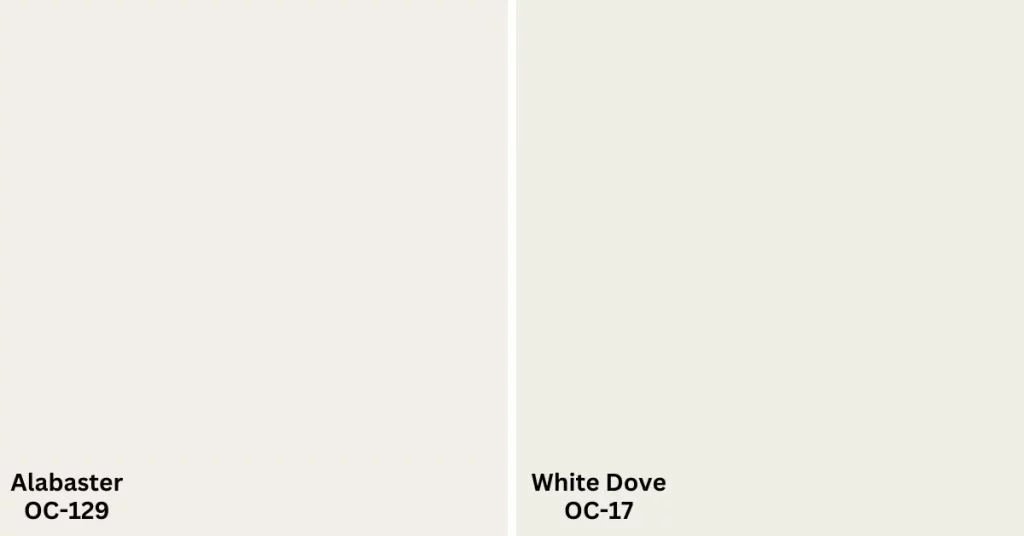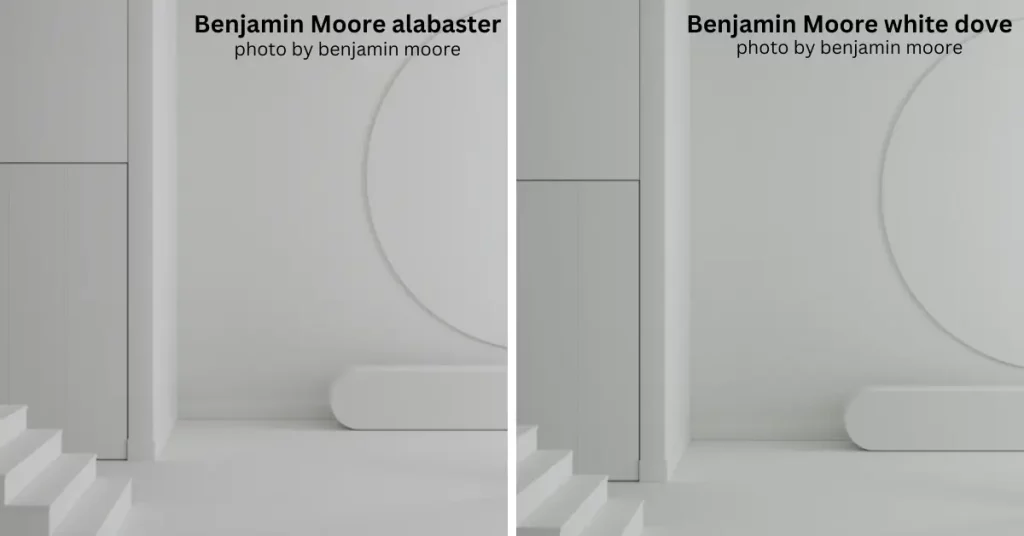Are you looking for a subtle difference between Benjamin Moore’s Alabaster and White Dove? Both are popular whites with different shades, tones, lighting effects and contrasting color schemes that can make all the difference.
When deciding which one is right for your room, understanding the differences between these two paints can make all the difference. Here, we will explore the nuances of each of these classic whites so that you can choose the perfect paint for your space.

Comparisons Between Benjamin Moore Alabaster vs White Dove
When picking the perfect wall color for your interior design project, Benjamin Moore’s Alabaster and White Dove are two of the most popular choices. Both paints are high-quality products that offer beautiful, timeless shades that can instantly brighten up any space. You can check Benjamin Moore’s Alabaster vs Sherwin William’s Alabaster to know the differences between these two alabasters.
But what makes each of these paints unique from one another? To better understand their differences and similarities, let’s take a closer look:
01: Shades and Tones
When comparing Benjamin Moore’s Alabaster and White Dove, the differences in shades and tones are pretty noticeable. Alabaster is a warm off-white shade with subtle yellow undertones, while White Dove is a cooler white with hints of gray.

This distinction in warmth makes Alabaster appear more inviting than White Dove, as it has a naturally warmer feel. When using Alabaster in interiors, one can easily create a cozy but airy atmosphere.
On the other hand, White Dove is better suited for modern looks that prioritize straightforwardness over softness. Also, due to its lack of bold colors, White Dove can open up small spaces and make them appear more spacious than they are.
Another difference between these two whites lies in their luminosity. Alabaster contains high-intensity white pigments that reflect much more light than White Dove. Therefore, when painting walls with Alabaster, the room will become instantly brighter and lighter than when painted with White Dove.
This can be useful for addressing issues with dark spaces without resulting in stark lighting solutions such as natural or artificial lights. Lastly, when it comes to the depth of color between Benjamin Moore’s Alabaster and White Dove, there isn’t very much difference. Both colors have a consistent level of saturation across all surfaces.
02: Lighting Effects
In general, both colors appear brighter with incandescent or natural light sources than with fluorescent bulbs or LED fixtures because these artificial lighting sources tend to produce cooler white hues than natural light sources.

But, this effect is more noticeable on White Dove than on Alabaster which remains relatively unchanged across different lighting sources due to its warm tone. Also, when exposed to direct sunlight, both Benjamin Moore colors may experience fading over time.
Despite its higher luminosity, Alabaster usually exhibits less of this effect than White Dove due to its higher light-reflecting properties. This means it tends to reflect rather than absorb light.
Lastly, think about how they will look together when choosing lights and paint colors. For example, if you use fluorescent bulbs with Benjamin Moore color, the overall ambiance will be cool. If you use incandescent bulbs, the overall ambiance will be warmer.
03: Contrasting Color Schemes
When using contrasting color schemes involving either Benjamin Moore Alabaster or White Dove, it’s crucial to consider how well each color complements the other(s).
For example, if you want to use bright blue accents, then using Benjamin Moore white paint would work well. Alabaster would add warmth while still allowing the blue accents to stand out. White dove would provide a strong contrast and make the blue appear even brighter. It would also have a calming effect.
Another way to use white paint is to pair different shades together. This can create a softer look where blues can blend in instead of standing out. For example, kitchen cabinets painted alabaster with a ceiling painted white dove might create the subtle contrast needed to create an elegant but inviting atmosphere in the cooking space.
04: Durability
Regarding durability, both paints provide a long-lasting finish that stands up to wear and tear and exposure to the elements. Both paints can maintain their finish for many years with proper care and maintenance.
In terms of performance, Benjamin Moore Alabaster is slightly more durable than White Dove. It has advanced technology that makes it more resistant to fading and staining, providing a longer-lasting finish than other paints.
It also offers better dirt resistance and easier cleanability than White Dove paint. But, White Dove does have a higher degree of moisture resistance which can be crucial in areas with high humidity or moisture levels.
In terms of longevity, Benjamin Moore Alabaster is the clear winner here. Its advanced technology allows it to keep its finish with proper care and maintenance for several years, while White Dove is less likely to do so. This means that if you’re looking for paint that will last you through many years of use without any need for repainting, then Alabaster is the way to go.
05: Popular Uses
Benjamin Moore Alabaster is often used in rooms with high traffic or activity because of its increased durability compared to White Dove. Its ability to withstand wear and tear makes it ideal for hallways and family rooms where children or pets play or run around frequently.
On the other hand, White Dove works better in bedrooms or living areas as it has less sheen than Benjamin Moore Alabaster, giving off a softer look that some people prefer in these spaces. Also, its increased moisture resistance makes it perfect for bathrooms or kitchens where there are likely to be higher levels of humidity present throughout the year.
06: Maintenance
When choosing between Benjamin Moore Alabaster and White Dove paint, maintenance should also be taken into consideration. Generally speaking, both of these paints require minimal maintenance after application, with any dust or dirt easily removed with a damp cloth or sponge once dry. But there are some slight differences between them nonetheless.
White Dove requires less frequent repainting than Benjamin Moore Alabaster due to its higher UV light resistance, so if you’re looking for paint that won’t need reapplication anytime in the near future, this may be your best bet. Especially if you’re looking at painting something outdoors that will get more direct sunlight exposure over time.
Benjamin Moore Alabaster offers better protection from water damage, so if you’re painting something indoors that may come into contact with water, like a kitchen backsplash or bathroom walls, this product might be better suited for you.
And because of its higher moisture resistance, mold growth is less likely, which means fewer worries about maintaining this paint over time since it won’t need repainting as often as White Dove would under similar circumstances.
What Are the similarities between Benjamin Moore’s Alabaster and White Dove?
Similarities in Color
Both colors have a hint of yellow, which prevents them from looking too stark or sterile. The shades of white are so alike that it can be difficult to tell the difference between them without having examples side-by-side. Moreover, compared to other whites on Benjamin Moore’s paint deck, they appear almost identical.
Similarities in Finish
Alabaster and White Dove not only mirror each other in terms of color but also when it comes to finishing. Both paints are available with either matte or eggshell finishes, so customers can choose the one that best suits their interior design style and preferences.
Similarities in Popularity
Benjamin Moore’s Alabaster and White Dove continue to be among some of the most popular paint colors sought after by homeowners everywhere. This is likely due in part to their versatility. These shades look great with almost any other color, making them neat additions to all styles, from classic to contemporary designs.
Subtle Differences in These Popular White Paints
While both Benjamin Moore Alabaster and White Dove are popular white paints, several distinct differences between them should be considered when selecting paint for your job.
Alabaster is slightly warmer than White Dove with a lower LRV and more of a yellow-tinted undertone, whereas White Dove has a higher LRV and a more grayish hue.
Depending on what look you’re going for, either could work perfectly in any room, whether it is residential or commercial. However, understanding the nuances between these two whites can help determine which paint would be best suited for your desired look.
Tips for Choosing Between Alabaster and White Dove
To make the final decision between Alabaster and White Dove, consider the following tips:
- Take into account the overall style and mood you wish to achieve in your space.
- Consider the existing furniture and decor in the room and how each shade will complement or contrast with them.
- Test samples of both Alabaster and White Dove on your walls to see how they look in different lighting conditions.
- Seek inspiration from design magazines, online platforms, and professional interior designers to see how these colors are used in various settings.
- Trust your instincts and choose the color that resonates with you the most.
Conclusion: Making the Final Decision
Choosing the right paint color for your space is a significant decision that can greatly impact the overall look and feel of your home. Benjamin Moore offers two popular off-white shades, Alabaster and White Dove, each with its own unique characteristics and undertones. By understanding the differences between these colors and considering your personal preferences and the needs of your space, you can make an informed decision. Whether you opt for the warm and inviting Alabaster or the clean and fresh White Dove, both shades are sure to enhance the beauty of your home. Take the time to test samples, seek inspiration, and trust your instincts. With careful consideration, you’ll find the perfect hue that will transform your space into a true reflection of your style and personality.

S. Pushon is a paint expert, self-taught artist, and currently working as an adviser in the paint industry as a Quality Improvement and Development Assistant.
An artist by heart, he draws remarkable art pieces and as a professional paint industry individual, he seeks the insight and shares with enthusiasts. Read more…

